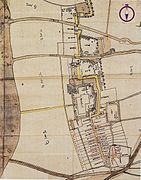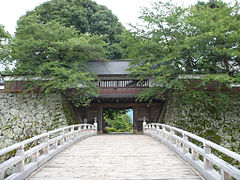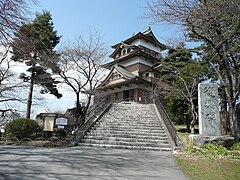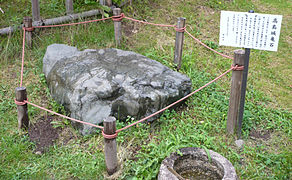Takashima Castle
| Takashima Castle | ||
|---|---|---|
|
Takashima Castle |
||
| Creation time : | before 1553 | |
| Castle type : | Hirajiro (Lower Castle) | |
| Conservation status: | Partly reconstructed | |
| Place: | Suwa | |
| Geographical location | 36 ° 2 '23.3 " N , 138 ° 6' 43.3" E | |
|
|
||
The Castle Takashima ( Japanese 高島城 , Takashima-jō ) is located in the city of Suwa , Nagano Prefecture . In the Edo period , the Suwa , who belonged to the smaller Fudai daimyo , resided there .
history
Takashima Castle has been the seat of the Suwa daimyo since ancient times. The Suwa had originally been high priests at the shrine there and had had influence as landowners. In 1553 Takeda Shingen occupied the castle and gave it to Itagaki Nobukata . In 1582 it was destroyed by Oda Nobunaga's troops. Thereafter, a vassal of Toyotomi Hideyoshis , Hineno Takayoshi ( 日 根 野 高 吉 ; 1539–1600) planned the reconstruction in 1590 , which was then carried out by his son Yohikaira ( 吉明 ; 1587–1656). In 1601 Yoshiakira was transferred, and with Suwa Yorimizu ( 諏 訪 頼 水 ; 1571–1641) another Suwa took over the castle. The Suwa remained lords of Takashima until the Meiji Restoration in 1868.
The attachment
The castle was originally built on a headland parallel to the bank into Lake Suwa, so that the lake was used as a moat. In addition, only the side facing the bank had to be protected by strong walls. From north to south, behind the main gate ( 大 手 門 , Ōte-mon ), the bastion Koromo-no-nami ( 衣 之 波 曲 輪 , Koromo-no-nami kuruwa ) followed each other , then over a bridge the San-no-maru ( 三 の 丸 ), over another bridge the Ni-no-maru ( 二 ノ 丸 ), which surrounded the central area, the Hommaru ( 本 間 ), on three sides. During the Edo period , siltation increased, so that in the 1850s low fields stretched on the west side.
Today the castle, of which only the Hommaru remained, lies in the middle of the city of Suwa and is now a public park. The moat was preserved on the north and east sides. In 1970 the castle tower with its side tower and watchtowers was rebuilt. The roofs of the castle tower were originally covered with shingles, these were replaced by copper sheets during the - not exact - replica. The avenue leading to the castle (A) still exists. Only the original maple trees have been replaced by the Japanese elm.
photos
Remarks
- ↑ Sheet “Shiojiri” ( 塩 尻 ) from the color woodcut series “The 69 Stations of Kiso-kaidō” ( 木 曽 街道 六 十九次 , Kiso-kaidō rokujūkyū tsugi ), drawn by Keisai Eisen (1790–1848). View from the south of the lake with Mount Fuji in the background. Even then, the castle was probably no longer directly on the water.
literature
- Takada, Tōru: Takashima-jo in: Miura, Masayuki (ed.): Shiro to jinya. Tokoku-hen. Gakken, 2006. ISBN 978-4-05-604378-5 , p. 100.
- Nishigaya, Yasuhiro (Ed.): Takashima-jo. In: Nihon meijo zukan, Rikogaku-sha, 1993. ISBN 4-8445-3017-8 .
- Papinot, Edmond: Historical and Geographical Dictionary of Japan. Reprinted by Tuttle, 1972 edition of 1910 edition. ISBN 0-8048-0996-8 .








